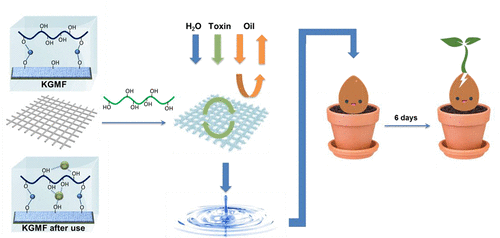当前位置:
X-MOL 学术
›
ACS Sustain. Chem. Eng.
›
论文详情
Our official English website, www.x-mol.net, welcomes your
feedback! (Note: you will need to create a separate account there.)
Highly Biocompatible, Underwater Superhydrophilic and Multifunctional Biopolymer Membrane for Efficient Oil–Water Separation and Aqueous Pollutant Removal
ACS Sustainable Chemistry & Engineering ( IF 7.1 ) Pub Date : 2018-01-11 00:00:00 , DOI: 10.1021/acssuschemeng.7b04219 Minxiang Zeng 1 , Ian Echols 1 , Pingmei Wang 2, 3 , Shijun Lei 1 , Jianhui Luo 2, 3 , Baoliang Peng 2, 3 , Lipeng He 2, 3 , Lecheng Zhang 1, 4 , Dali Huang 5 , Carlos Mejia 1 , Ling Wang 1 , M. Sam Mannan 1, 4 , Zhengdong Cheng 1, 4, 5
ACS Sustainable Chemistry & Engineering ( IF 7.1 ) Pub Date : 2018-01-11 00:00:00 , DOI: 10.1021/acssuschemeng.7b04219 Minxiang Zeng 1 , Ian Echols 1 , Pingmei Wang 2, 3 , Shijun Lei 1 , Jianhui Luo 2, 3 , Baoliang Peng 2, 3 , Lipeng He 2, 3 , Lecheng Zhang 1, 4 , Dali Huang 5 , Carlos Mejia 1 , Ling Wang 1 , M. Sam Mannan 1, 4 , Zhengdong Cheng 1, 4, 5
Affiliation

|
Conventional wastewater treatment systems generally require multiple steps and complex procedures to remove aqueous pollutants and oil contaminants from polluted water. Herein, we fabricate an underwater superoleophobic membrane by cross-linking konjac glucomannan on pristine fabrics, demonstrating that the concept of oil–water separation and the principle of aqueous pollutant removal can be integrated. Such biopolymer-modified fabric not only separates oil–water mixtures with high efficiency (up to 99.9%), but also exhibits the intriguing characteristic of removing water-soluble pollutants (including polyaromatic dyes and heavy metal ions). As a proof of concept, the synthetic wastewater purified with biopolymer membranes was used to cultivate and irrigate pinto beans, causing no observable deleterious effect on seed germination and growth. These results further confirm the biocompatibility and effectiveness of biopolymer membranes, offering an encouraging solution to challenges including wastewater treatment and cleanup of oil spills.
中文翻译:

高度生物相容性,水下超亲水性和多功能生物聚合物膜,可有效分离油水和去除水污染物
传统的废水处理系统通常需要多个步骤和复杂的程序才能从污水中去除水污染物和油污染物。在这里,我们通过在原始织物上交联魔芋葡甘露聚糖来制造水下超疏油膜,证明油水分离的概念和水污染物的去除原理可以整合在一起。这种经过生物聚合物改性的织物不仅可以高效分离油水混合物(高达99.9%),而且还具有去除水溶性污染物(包括多环芳族染料和重金属离子)的吸引人的特性。作为概念的证明,使用生物聚合物膜纯化的合成废水用于种植和灌溉斑豆,对种子的发芽和生长没有明显的有害影响。
更新日期:2018-01-11
中文翻译:

高度生物相容性,水下超亲水性和多功能生物聚合物膜,可有效分离油水和去除水污染物
传统的废水处理系统通常需要多个步骤和复杂的程序才能从污水中去除水污染物和油污染物。在这里,我们通过在原始织物上交联魔芋葡甘露聚糖来制造水下超疏油膜,证明油水分离的概念和水污染物的去除原理可以整合在一起。这种经过生物聚合物改性的织物不仅可以高效分离油水混合物(高达99.9%),而且还具有去除水溶性污染物(包括多环芳族染料和重金属离子)的吸引人的特性。作为概念的证明,使用生物聚合物膜纯化的合成废水用于种植和灌溉斑豆,对种子的发芽和生长没有明显的有害影响。











































 京公网安备 11010802027423号
京公网安备 11010802027423号